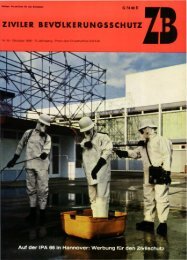Zivilschutz- Forschung - Bundesverwaltungsamt
Zivilschutz- Forschung - Bundesverwaltungsamt
Zivilschutz- Forschung - Bundesverwaltungsamt
Sie wollen auch ein ePaper? Erhöhen Sie die Reichweite Ihrer Titel.
YUMPU macht aus Druck-PDFs automatisch weboptimierte ePaper, die Google liebt.
146. Pfaff, B. L. (1998). „Emergency department management of nerve agent<br />
exposure.“ Int J Trauma Nurs 4(3): 71-8.<br />
147. Philipp, R. (1996). „Surveillance systems and the role of a preventive<br />
medical team in chemical incidents.“ Occup Environ Med 53(7): 502.<br />
148. Piccinini, N., G. N. Ruggiero, et al. (2000). „Risk of hydrocyanic acid release<br />
in the electroplating industry.“ J Hazard Mater 71(1-3): 395-407.<br />
149. Polakoff, P. L. (1986). „Treating chemical skin burns varies between acids<br />
and alkalies.“ Occup Health Saf 55(3): 24-5.<br />
150. Posniak, M. (2000). „[Chemical hazards in fire-fighting environments].“<br />
Med Pr 51(4): 335-44.<br />
151. Rastogi, S. K., B. N. Gupta, et al. (1988). „Effect of exposure to toxic gas<br />
on the population of Bhopal: Part II – Respiratory impairment.“ Indian J Exp<br />
Biol 26(3): 161-4.<br />
152. Reich, M. R. and J. K. Spong (1983). „Kepone: a chemical disaster in<br />
Hopewell, Virginia.“ Int J Health Serv 13(2): 227-46.<br />
153. Rivkind, A., P. Barach, et al. (1997). „Emergency preparedness and<br />
response in Israel during the Gulf War.“ Ann Emerg Med 30(4): 513-21.<br />
154. Robertson, A. G. and D. J. Morgan-Jones (1994). „First line nuclear, biological<br />
and chemical defence training – the way ahead.“ J R Nav Med Serv<br />
80(2): 90-4.<br />
155. Robertson, J. S. (1993). „Chemical disasters, real and suspected.“ Public<br />
Health 107(4): 277-86.<br />
156. Rodgers, J. (1998). „A chemical gas incident in London: how well prepared<br />
are London A & E departments to deal effectively with such an event?“ Accid<br />
Emerg Nurs 6(2): 82-6.<br />
157. Rodgers, J. C. (1998). „Chemical incident planning: a review of the literature.“<br />
Accid Emerg Nurs 6(3): 155-9.<br />
158. Rosenbaum, C. (1993). „Chemical warfare: disaster preparation in an Israeli<br />
hospital.“ Soc Work Health Care 18(3-4): 137-45.<br />
159. Rotz, L. D., D. Koo, et al. (2000). „Bioterrorism preparedness: planning for<br />
the future.“ J Public Health Manag Pract 6(4): 45-9.<br />
160. Sarangi, J., I. Mackenzie, et al. (1995). „Responsibilities and resources of oncall<br />
public health doctors.“ Health Trends 27(2): 46-9.<br />
161. Sauer, S. W. and M. E. Keim (2001). „Hydroxocobalamin: improved public<br />
health readiness for cyanide disasters.“ Ann Emerg Med 37(6): 635-41.<br />
162. Scully, T. and B. Proctor (1994). „Prompt diagnosis, treatment critical in<br />
workplace burn emergency response.“ Occup Health Saf 63(3): 80-1.<br />
163. Sefrin, P. (1991). „Handbuch für den Leitenden Notarzt.“ Ecomed.<br />
164. Shapira, Y., Y. Bar, et al. (1991). „Outline of hospital organization for a chemical<br />
warfare attack.“ Isr J Med Sci 27(11-12): 616-22.<br />
165. Shapira, Y., Y. Bar, et al. (1991). „Outline of hospital organization for a chemical<br />
warfare attack.“ Isr J Med Sci 27(11-12): 616-22.<br />
230

















